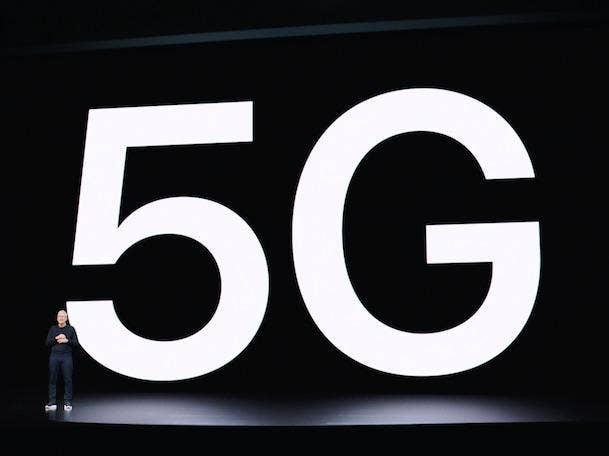Verizon 5G Footprint Will ‘Nearly Double’ In 2021 As Carrier Predicts Business Services Headwinds
The carrier experienced revenue declines within its business segment, especially in the enterprise space, in fourth-quarter 2020. 5G will be the focus in 2021, says Verizon CEO Hans Vestberg.

Verizon’s strong core connectivity business helped offset the financial burden of the COVID-19 pandemic during the last fiscal quarter of 2020.
For 2021, the carrier has its sights set on 5G. CEO Hans Vestberg told investors during the carrier’s fiscal fourth-quarter 2020 conference call Tuesday that Verizon has plans to aggressively grow its 5G footprint.
Vestberg said Verizon plans to “almost double” the amount of 5G availability in the U.S. during 2021. The carrier is planning to light up 30 thousand sites and 20 thousand cities with 5G ultra-wideband connectivity by the end of 2021.
“We deployed more than five times more 5G ultra wideband sites in 2020 and we launched nationwide 5G,” he said. “When it comes to 5G and investing in our business, we have a big year in front of us.”
[Related: Channel Changes For Verizon As Carrier Crowns New Channel Chief: Exclusive]
Basking Ridge, N.J.-based Verizon’s Business segment struggled overall in the last quarter of the year, but the public sector business shined as educational institutions and state and local governments adopted virtual collaboration and remote working solutions.
Total operating revenue for Verizon Business, which includes the company’s Global Enterprise Solutions, small and midsize business, public sector and wholesale businesses, dipped 0.3 percent to $8.05 billion during the fourth quarter of 2020 compared with $8.07 billion in the year-ago period. The carrier attributed the results to continued economic weakness for businesses due to the COVID-19 pandemic.
Global Enterprise Solutions revenue especially felt the brunt of the financial fallout from the pandemic, dropping 5.5 percent to $2.60 billion in revenue in fourth-quarter 2020 compared with $2.74 billion a year ago. SMB revenue dropped 2.8 percent during the quarter to $2.96 billion from $3.07 billion in the year-ago period, due to impacts from the pandemic. Public sector, however, grew an impressive 16.1 percent to $1.73 billion during the quarter compared with $1.49 billion last year. Wholesale revenue continued to slide, falling 3.6 percent to $744 million from $772 million in fourth-quarter 2019.
“There are uncertainties as to how businesses will perform in 2021, given the challenges in the macro environment. The elevated demand in public sector and parts of enterprise throughout 2020 could create headwinds to growth in the business segment, particularly in the back half of 2021,” said Matt Ellis, Verizon’s executive vice president and CFO.
Verizon also expects SMB revenue to be “subdued” in 2021 as the economy recovers, Vestberg said.
Verizon gained 703,000 retail postpaid net additions, including 279,000 phone net additions and 442,000 postpaid smartphone net additions. The carrier said that 346,000 retail postpaid net additions and 116,000 phone net additions came from the Verizon Business unit.
The carrier also said it delivered on its promise to extend its network leadership position through innovation and partnerships. Vestberg pointed to Verizon's partnerships with Amazon Web Services and Microsoft for its 5G Mobile Edge mobile compute platform, which lets developers and enterprises deploy ultralow latency-dependent applications to mobile and connected wireless devices at the edge of Verizon’s 5G ultra wideband network. The carrier said it will continue to expand its partner ecosystem in this area.
Verizon since 2019 has been working through companywide business and executive team restructuring, as well as its Voluntary Separation program, which included early retirement buyout deals to thousands of its employees in an effort to achieve $10 billion in cumulative cash savings by 2021. Ellis said that that the carrier has so far realized $9.5 billion in savings and Verizon is on track to hit its goal before its target of the year’s end.
“COVID-19 has brought about new ways of working and we believe some of these will be long term in nature. This will create new savings opportunities beyond the current program,” Ellis added.
For the fourth quarter of the year, which ended Dec. 31, Verizon reported operating revenue of $34.69 billion, down 0.2 percent from $34.77 billion. The carrier’s net income fell 9.6 percent in the quarter to $4.71 billion, down from $5.22 billion during the same period last year. Verizon reported diluted earnings per share of $1.11, down 9.8 percent compared with diluted earnings per share of $1.23 during fourth-quarter 2020. Verizon said wireless equipment weakness and continuing declining legacy wireline sales impacted its financial results.
Revenue headwinds from the COVID-19 pandemic that were seen earlier in 2020 subsided in the fourth quarter, according to Verizon.
For 2021, Verizon expects services and other recurring revenue growth driven by wireless and 5G to anchor the business, the carrier said.